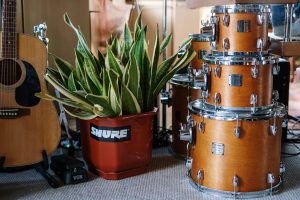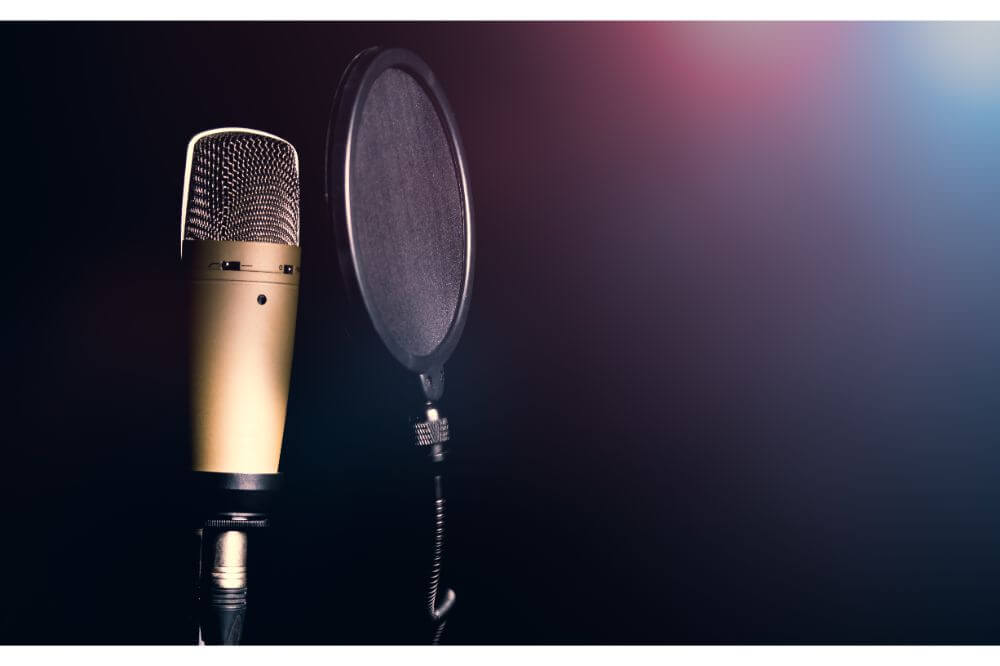Updated on December 23rd, 2021
In the percussion family, the snare drum is an instrument that is considered a primary part of the drum kit and is used in several bands. Typically, the snare drum is played with a drumstick and can be used in concert bands, marching bands, parades, drumlines, and pop music and rock bands. The snare drum is the smallest cylinder drum and is often referred to as the side drum. The snare drum is derived from a drum that was originally used to accompany a flute, the tabor. There are two heads on the snare drum, and they are most commonly made of plastic, but some are made of calfskin. 
What Are the Parts of a Snare Drum?
Head
The head is the surface of the snare drum which drummers strike, and the snare-side head is called its opposite side. Coated-batter heads for modern snare drums are commonly used as materials.
Hoops and Rims
Hoops or rims are what can be seen around the head of the snare, and it holds it all together. The other snare sections that dictate the sound of the entire instrument are also housed in the Rims.
What you can find on most snare drums today are die-cast and triple-flange metal hoops. Aside from aesthetics, there are a few variations between the two. Die-cast hoops, particularly for noisy rimshots, provide a more robust feel. They often appear to reduce the ring of the drum and create fewer overtones.
In comparison, triple-flange hoops can make it possible for the drum to ring longer, create more overtones, and produce greater sensitivity to the snare. Depending on the characteristics of the shell, manufacturers often match hoops to shell designs, but it's essentially a matter of personal preference.
Shell
Shells give the round appearance of snare drums, and they typically have an influence on the sound that the snare makes. The material used for the shell often factors into the consistency of the sound.
While most wood shells are produced by heat and compression from multiple thin plies moulded into a rigid shell, others are made from a single dense, steam-bent ply. To shape the shell, some custom drum makers often use staves, or wood segments, which are glued together.
The top and bottom of thinner shells are often attached to reinforcement rings and may be constructed from the same wood species as the rest of the shell or from a different material. Looking up what kind of snare on a couple of your favourite recordings was used will help you pin down some of the sounds that will produce different shells. There are also lots of snare-demo videos on YouTube, as well as on the website of most drum producers
Strainer
This system keeps the snares against the drum head's snare-side and provides you, the drummer, with a way to change the wire tension.
Mounting
The most common mounting option is the standard three-legged stand along with a few sporting alternatives for adding a sling.
Lugs and Tension Rods
These two serve as the drum head's tensioning mechanism, and they ensure that the shell is touched by less metal, which affects the consistency of the sound created by the snare. They are located on the shell's sides and are balanced using a drum key.
Tube lugs have less metal than split or have long lugs in direct contact with the casing, thereby enhancing sustainability and offering a slightly different tone. There are several innovative split-lug designs, and these are perhaps the most identifiable visual feature of the drums of a specific manufacturer. Other drumhead tensioning methods, such as rope systems, are used now and then, but for drum designers, tension rods are still the usual alternative.
Snare Wires
When the head is struck, these delicate wire strands give snare drums their distinct tone. Different types of wires are also used to produce different sounds. By engaging with the snare-side head when the drum is stuck, these small, delicate strands give the snare drum its characteristic sound. Usually, drum set snare drums use snares made of coiled wire, often referred to as snappy snares. At all dynamic stages, these give the drum a bright tone, are very sensitive and do not muffle the sustain as much as other wire designs do. How Does a Snare Drum Work?
How Does a Snare Drum Work?
With a drumstick or beater that can range from brushes to drummers, the drummer strikes the snare drum head. This act forces the head down, allowing the transmitted energy to vibrate and disperse until it is completely dissipated by sound waves. By altering the sound depending on the intensity of the force and the amount of stress under which the snare wires are, the snare wires respond to this force. As you adjust the amount of force you use on the drumsticks, the sound then changes. Some experienced drummers change the way they strike the snares to create another sound collection, while another method often involves hitting one of the drumsticks as it lies over the head of the drum.
Still, another technique is to strike the rims or hoops instead of the staccato to create a flat beat.
How to Tune a Snare Drum?
Follow the steps below to tune your snare drum ideally:
1. Know Your Drum
Understanding your drum is the first main factor behind tuning your snare. Many types of shell will play into how you end up tuning the snare. Hardwoods such as maple, birch, cherry, oak, walnut and mahogany are popular snare materials, as well as alternative materials such as carbon fibre, fibreglass, and acrylic. Metal snare drums continue to be extremely popular: on many of your favourite records, you can hear brass, steel, copper, bronze and aluminium.
For tuning, understanding how the material plays into sound production is important. Metal-shelled drums, for instance, can result in more volume and rings than wood. Various forms of metal can also produce various sounds. Steel is going to be lighter than copper and aluminium is going to be drier than brass.
2. Rings and Buzzing Sounds
Drummers are also hyper-focused on ring elimination while tuning. However, in certain cases, a ring is fine. When miked, Ring works in live situations. With a more restricted dynamic range, eliminating the ring would give the drum a very pronounced, concentrated tone. However, at a lower frequency, the articulation would be improved. Bear in mind that the ring will be absorbed by the band finally. This is usually referred to as 'sympathetic snare buzz' if you are hearing a' buzz' sound, which means that the bottom head of one of your toms is tuned to the same pitch as your bottom snare head. With speciality snare wires, you can minimize this, but don't expect them to save the day.
3. Drum Heads- Old or New?
You will hear the sound of the drums change as you practise. The more you play, the more it takes for your drums to be tuned. The drum heads would need to be replaced after prolonged use. The old heads are not going to keep the melody as well, and they're going to wear out and split eventually. There are a lot of head styles, so what kind of head do you use? A different tone is created by each kind of head, and some are more robust than others.
4. Drum heads are of the following types:
- Single Ply
The most popular head types are single-ply drum heads. They create a brighter sound and are the sort of head that is least durable. For jazz and light rock, this type of drum head is fine.
- Double Ply
Double-ply drum heads sound darker and are ideal for heavy metal music, both heavier, louder kinds. They have a darker sound and are more durable.
- Coated
There is a sprayed-on coating on coated drum heads that darkens the drum tone and decreases the amount of "ring" or overtones. They're even more resilient than heads that are uncoated, or transparent.
- Pre-dampened
Pre-dampened drum heads have a damping mechanism built in to regulate the drum overtones. These are often referred to as mufflers and are used on kick drums most frequently. With fewer overtones, they create a very regulated, centred sound.
It's a smart idea to switch your batter heads every six months to a year if you play regularly. The snare drum is struck more often, so it will need to be replaced more often. In general, Kick Drum Heads last the longest. It is not necessary to replace resonant heads as much as batter heads; you can normally change them every second or third time your batter heads are changed.
5. Start With the Resonant Head
Start with the resonant head while tuning the drum. Bear in mind that the head is always very small on the resonant, or snare-side. It may be weaker than other heads, but still enough light to rest on its own. For a two-key method, this should be mounted and centred in a way and settled in place.
6. Move to the Batter Head
Next, move on to the batter head and repeat the procedure with the bottom head you used. Tune the drum up steadily until it's at around the same pitch as the bottom head.
7. Tuning
Start by making the tension finger tight. This only means tightening using your fingers instead of using tools. Each side of the snare bed should have wrinkles between the lugs. Make use of two keys on either side with enough friction to eliminate wrinkles, instead of removing the wrinkles by tight tuning. Avoid turning the lower head very tight. It's usually tighter than one would expect when we say "very tight". Be sure to place them equally on the drum when positioning the wires on the bottom, so when the throw off (switch to turn wires on or off) is engaged, the wires have an even tension around the drum. A common mistake is to make the snare wire tension very tight which ends up choking the drum sound. Medium tension should do the job.
8. Use a Drum Key
You'll use a drum key to tighten the tension rods when tuning your drum heads. Offer every rod a half-turn using a diagonal pattern, progressively bringing the drum up to pitch. This even holds the strain on the head of the drum. Tap the drum head gently with a stick close to the edge of the head as you're tuning, using the rods as a reference. When the stress is even, the pitch of each region should be the same.
9. Stay Attentive to the Sounds
This could be obvious for a drummer. Tuning, however, requires listening in the process to ensure that you strike the right note. Take each lug up until they are at the preferred tightness by quarter-turns. With a slight bell, the head will start creating a toppy or tinny tone. Heads have to be pitched equally and to do this, the snare needs a little bit more fuss.
Pitch is dependent on choice, but if the resonant head is reasonably tight, no matter the size, the drum works best most of the time. Ultimately, to decide when to stop, use your ears.
10. Determining the Correct Tuning
There are three ways to tune a drum: a resonant (bottom) head higher than the head of the batter, a resonant head lower than the head of the batter, and both heads tuned to the same pitch.
The evenest tone is created by tuning the heads the same, tuning the bottom head tighter than the top gives the notes a slight upward bend, and tuning the bottom head lower than the top gives the pitch a slight downward bend. Experiment with ranges for drum tuning and find the sound you want.
11. Play
While tuning, you were probably sound-checking, but now it's time to play. This is a perfect time to make sure everything is where it needs to be for a final evaluation. At this stage, there may be a few minor modifications left. Tighten the change knob by a quarter or a half-turn if the snare rattles too much. Until it is fine, play between each modification. If it is too tight, the bad tune will be heard and the drum will choke.
Get ready from here to play, record, or jam with your band.
More to read:
5 Best Cajon Drums Available On the Market Now 2021.
We hope you love our reviews! For your information, we do earn money from commission in the link in the content! For more information click here!















